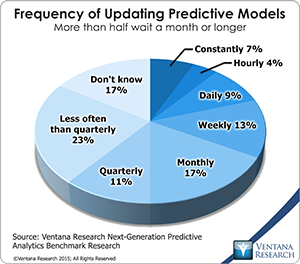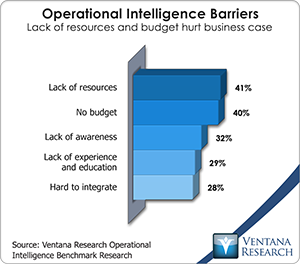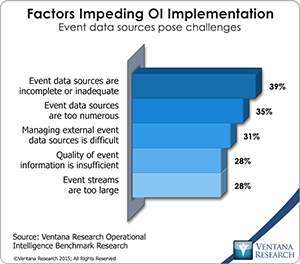A new company has emerged in the market for real-time analytics software. Anodot came out of stealth mode in late 2015 with $3 million in funding. It is led by three founders: CEO David Drai, whose company Cotendo was acquired by networking company Akamai Technologies in 2012; Ira Cohen, chief data scientist, who previously held that position at Hewlett-Packard; and Shay Lang, who serves as VP of R&D. Unlike most vendors in the space, the company is delivering anomaly detection and operational intelligence through software as a service (SaaS).
Anodot’s technology uses pattern recognition to find anomalous data patterns and send alerts when something is out of the norm. Its customers currently are in three markets: the Internet of Things (IoT), Advertising Technology (AdTech) and e-commerce. We associate real-time analytics with operational intelligence, but increasingly it overlaps into other categories such as predictive analytics and machine learning. According to our predictive analytics benchmark research , only 7 percent of companies constantly update their predictive models, but automation of analytic model building, also known as machine learning, is a key consideration in pattern recognition systems required for operational intelligence and IoT systems.
, only 7 percent of companies constantly update their predictive models, but automation of analytic model building, also known as machine learning, is a key consideration in pattern recognition systems required for operational intelligence and IoT systems.
In the world of connected devices called IoT, one Anodot customer, a printing services company, is using the technology to look at printer failure before it happens by understanding anomalous patterns in usage, temperature, engine speed, voltage, error patterns and the like. This saves money by proactively servicing the printers (potentially remotely), limiting on-site visits from technicians and streamlining inventory management. Furthermore, since the service business is a recurring revenue model, it is able to meet SLAs and eliminate downtime, both of which could impact the revenue line.
For AdTech, one customer utilizes Anodot as part of the marketing optimization engine for its digital analytics and advertising platform. One of the challenges with large digital platforms is the enormous amount of real-time data funneling through from different platforms; that data must be analyzed in real time to produce appropriate recommendations. If the data fed through the system is bad, the recommendations will also be bad. Anodot helps address these data integrity issues by monitoring multiple streams of data and alerting of anomalous patterns that can represent bad data flowing through the system.
E-commerce is the third area where Anodot has multiple customers. One of them processes a half a billion events per day. E-commerce and Web-based businesses, similar to AdTech, need to analyze vast amounts of data in real time to keep sites running effectively and users satisfied. Furthermore, large e-commerce retailers can have many products that have to be matched to pricing without errors or the company can potentially lose significant money. With real-time error detection, such issues can be identified and system rules devised to prevent them.
Anodot’s product has some capabilities that should benefit it in the market. Its patented machine-learning algorithms enable the system to look at different types such as sparse data, irregular data, smooth data, multimodel data and discrete data, and apply the correct algorithm for the specific pattern. This is important because different categories of data exhibit different characteristics, and the correct algorithm must be applied to produce effective results. Based on these algorithms, the company provides thresholds for alerts that change as the data changes. When a threshold, or variable parameter, is reached, an alert can be sent for a human or machine to follow up. This approach is in contrast to the static thresholding that has been used for alerting. With static thresholds a calculation is made and variable parameters are set in advance. Such an approach may delay alerts or, worse, miss anomalies altogether.
A second interesting characteristic of Anodot is that it is offered as software-as-a-service. Among its advantages is not needing to store the underlying data but only the patterns of the data. Storing of data patterns enables the system to identify longer-term patterns, adjust algorithms and refine its accuracy in different scenarios over time.
Since the algorithms are prebuilt, users of the application do not need a data scientist to build models; business intelligence users or application developers can do that. This helps address a major demand in software evaluation, according to both our operational intelligence and predictive analytics research: usability.
 SaaS also relieves companies of maintaining their own hardware and software for anomaly detection; they can simply rent the application and save on licensing and administration. Anodot prices usage of the product on a monthly basis based on the number of metrics tracked, which typically ranges from $3,000 to $10,000 per month. In the past event-based systems have been expensive due to the necessities of installing them on-premises and training users. Anodot’s pricing model helps address the two most common barriers to the business case for operational intelligence: lack of resources, mentioned by 41 percent of research participants, and lack of budget, mentioned by 40 percent.
SaaS also relieves companies of maintaining their own hardware and software for anomaly detection; they can simply rent the application and save on licensing and administration. Anodot prices usage of the product on a monthly basis based on the number of metrics tracked, which typically ranges from $3,000 to $10,000 per month. In the past event-based systems have been expensive due to the necessities of installing them on-premises and training users. Anodot’s pricing model helps address the two most common barriers to the business case for operational intelligence: lack of resources, mentioned by 41 percent of research participants, and lack of budget, mentioned by 40 percent.
The platform’s cloud architecture enables it to stream events in a variety of time-series metric formats such as Graphite, StatsD, Coda Hale Metrics, and collectd. It also can connect to various applications and data sources using RESTful APIs and JSON. The ability to connect to many sources is a key consideration for such systems. According to our operational intelligence research, the most common barriers to implementation are incomplete event data sources (for 39% of organizations) and too many event data sources (35%).
According to our operational intelligence research, the most common barriers to implementation are incomplete event data sources (for 39% of organizations) and too many event data sources (35%).
We recommend that companies in AdTech, e-commerce and IoT, consider Anodot for some of the uses outlined above. OEMs and analytic service providers also may want to evaluate the system in the areas those mentioned above as well as in security and fraud prevention. Given its cloud-based architecture, Anodot fits well within developer operations (DevOps) frameworks and embedded analytics scenarios. To test the system, the vendor offers a free one-month trial.
Regards,
Ventana Research












